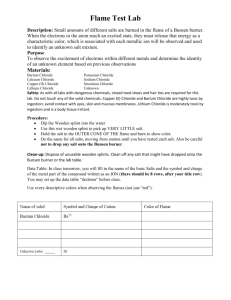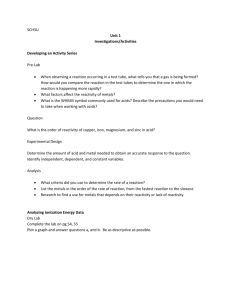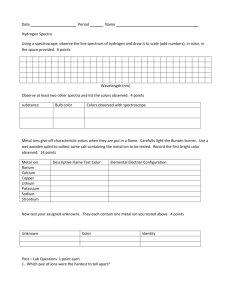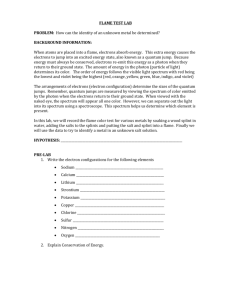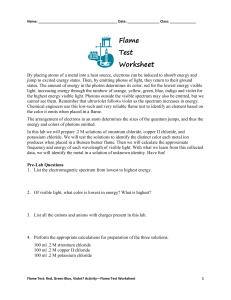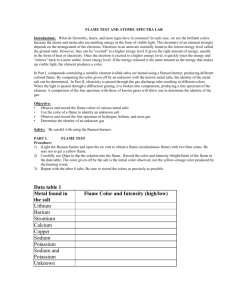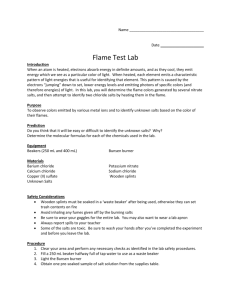Flame Test Safe Work Procedure & Activity Guide
advertisement
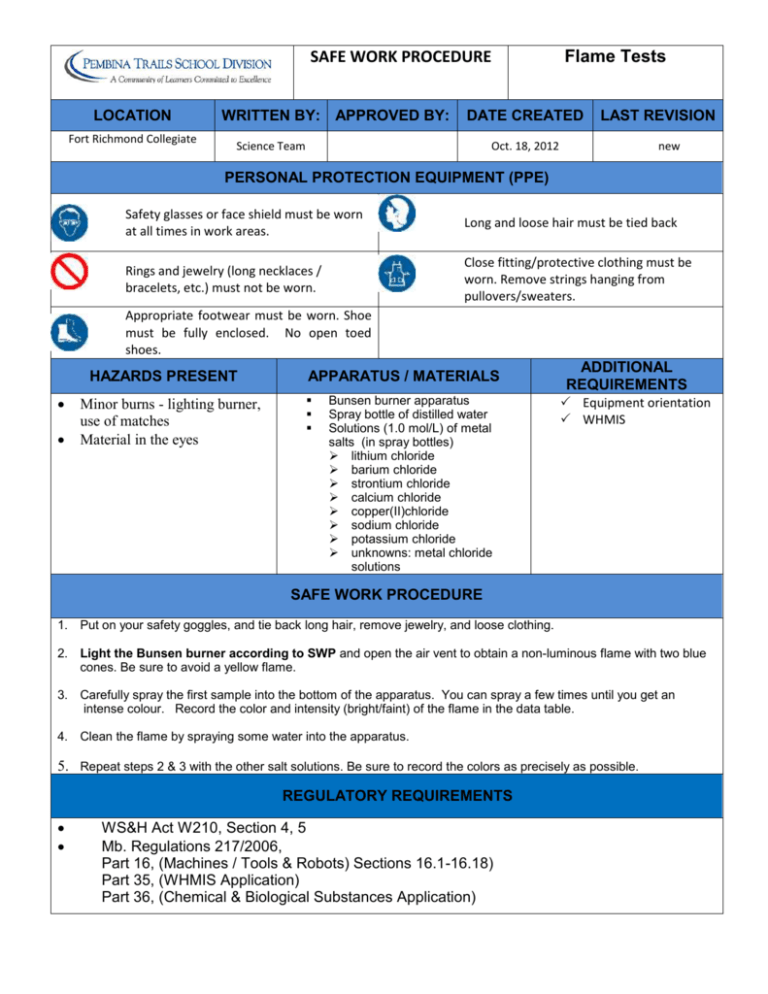
SAFE WORK PROCEDURE LOCATION Fort Richmond Collegiate WRITTEN BY: APPROVED BY: Flame Tests DATE CREATED Science Team LAST REVISION Oct. 18, 2012 new PERSONAL PROTECTION EQUIPMENT (PPE) Safety glasses or face shield must be worn at all times in work areas. Long and loose hair must be tied back Rings and jewelry (long necklaces / bracelets, etc.) must not be worn. Close fitting/protective clothing must be worn. Remove strings hanging from pullovers/sweaters. Appropriate footwear must be worn. Shoe must be fully enclosed. No open toed shoes. HAZARDS PRESENT Minor burns - lighting burner, use of matches Material in the eyes APPARATUS / MATERIALS Bunsen burner apparatus Spray bottle of distilled water Solutions (1.0 mol/L) of metal salts (in spray bottles) lithium chloride barium chloride strontium chloride calcium chloride copper(II)chloride sodium chloride potassium chloride unknowns: metal chloride solutions ADDITIONAL REQUIREMENTS Equipment orientation WHMIS SAFE WORK PROCEDURE 1. Put on your safety goggles, and tie back long hair, remove jewelry, and loose clothing. 2. Light the Bunsen burner according to SWP and open the air vent to obtain a non-luminous flame with two blue cones. Be sure to avoid a yellow flame. 3. Carefully spray the first sample into the bottom of the apparatus. You can spray a few times until you get an intense colour. Record the color and intensity (bright/faint) of the flame in the data table. 4. Clean the flame by spraying some water into the apparatus. 5. Repeat steps 2 & 3 with the other salt solutions. Be sure to record the colors as precisely as possible. REGULATORY REQUIREMENTS WS&H Act W210, Section 4, 5 Mb. Regulations 217/2006, Part 16, (Machines / Tools & Robots) Sections 16.1-16.18) Part 35, (WHMIS Application) Part 36, (Chemical & Biological Substances Application) Flame Tests Activity Introduction: Have you ever seen a fireworks display? Where do all of the colors come from? In this activity, you will investigate the colors of flame produced by solutions of metal salts. A flame test is a procedure used to test qualitatively for the presence of certain metals in chemical compounds. When the compound to be studied is excited by heating it in a flame, the metal ions will begin to emit light. Based on the emission spectrum of the element, the compound will turn the flame a characteristic color. This technique of using certain chemical compounds to color flames is widely used in pyrotechnics to produce the range of colors seen in a firework display. Certain metal ions will turn the flame very distinctive colors; these colors in turn can help identify the presence of a particular metal in a compound. However, some colors are produced by several different metals, making it hard to determine the exact ion or concentration of the ion in the compound. Some colors are very weak and are easily overpowered by stronger colors. In this activity, solutions of ionic salts are sprayed into a Bunsen burner apparatus. You will be able to see the different colored flames produced. By comparing the color given off by an unknown with the known metal salts, the identity of the metal salt can be determined. Flame Tests Activity Materials: Bunsen burner apparatus Spray bottle of distilled water Solutions (1.0 mol/L) of metal salts (in spray bottles) lithium chloride barium chloride strontium chloride calcium chloride copper(II)chloride sodium chloride potassium chloride unknowns: metal chloride solutions Procedure: 1. Light the Bunsen burner and open the air vent to obtain a non-luminous flame with two blue cones. Be sure to avoid a yellow flame. 2. Spray the first sample into the bottom of the apparatus. You can spray a few times until you get an intense colour. Record the color and intensity (bright/faint) of the flame in the data table. 3. Clean the flame by spraying some water into the apparatus. 4. Repeat steps 2 & 3 with the other salt solutions. Be sure to record the colors as precisely as possible. Data Table: Metal found in the salt Flame Color and Intensity Analysis: 1. List the colors observed in this lab from the highest energy to the lowest energy. 2. List the colors observed in this lab from the highest frequency to the lowest frequency. 3. List the colors observed in this lab from the shortest wavelength to the longest wavelength. 4. What is the relationship between energy, frequency, and wavelength? 5. Based on the results of your experiment, what metal was found in the unknown(s)? Explain. 6. Do you think we can use the flame test to determine the identity of unknowns in a mixture? Why or why not? 7. How are electrons “excited” in this part of the experiment? What does it mean when the electrons are “excited”? 8. Explain why we did not see distinct lines (like on an emission spectrum) when the metal salts were burned. 9. What particles are found in the chemicals that may be responsible for the production of colored light? 10. Why do different chemicals emit different colors of light? 11. Why do you think the chemicals have to be heated in the flame first before the colored light is emitted? 12. Colorful light emissions are applicable to everyday life. Where else have you observed colorful light emissions? Are these light emission applications related? Explain.
